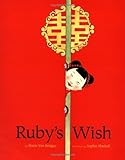Lesson 1: Predicting a Solution to a Problem
Lesson Plan
Ruby's Wish | 600L

- Learning Goal
- Predict the solution to a problem using text evidence.
- Duration
- Approximately 50 minutes
- Necessary Materials
-
Provided: Example Chart for Direct Teaching and Guided Practice, Independent Practice Passage, “Casey Saves the Play”
Not Provided: Ruby’s Wish by Shirin Yim Bridges, chart paper, markers
-
Teacher Modeling

will explain that as we read, we should pay attention to clues in the story that tell us what the solution may be to the problem. I will begin reading Ruby’s Wish by Shirin Yim Bridges, stopping at the page before Chinese New Year. I will chart the problem and one possible prediction of the solution. I will model identifying clues from the story that led me to the prediction. (Direct Teaching and Guided Practice Example Chart provided below in Teacher and Student Materials.)
-
Think Check
Ask: How did I make a prediction about the solution in a story? Students should respond that you read the story and stopped after the problem was identified. Then, you thought of a possible solution that may occur in the story, using evidence from the text to support your prediction.
-
Guided Practice

will predict a second solution to the problem in the story and chart solution clues from the story for the prediction. (Direct Teaching and Guided Practice Example Chart provided below.) We will finish reading Ruby’s Wish and discuss which prediction was accurate.
-
Independent Practice

will read “Casey Saves the Play” and write a prediction about the solution to the problem in the story. You will give reasons for your prediction, based on clues given in the story. (Student Independent Practice is provided below.)
TIP: Students struggling with organizing their writing in the Independent Practice can chart the problem, possible solutions, and text evidence using the Direct Teaching and Guided Practice chart as a guide.
Texts & Materials
Standards Alignment
(To see all of the ReadWorks lessons aligned to your standards, click here.)



This was a very helpful lesson plan for this story book. I noticed that there were many vocabulary words in the story that I had to introduce beforehand so as not to interrupt the flow during reading time.
Excellent!! well- connected to lesson objective.